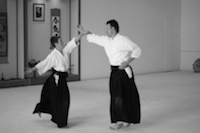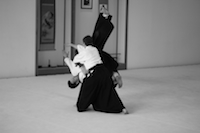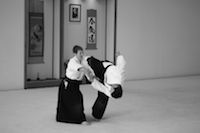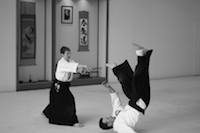
Home
About Our Dojo
Instructors
Aikido classes
for Adults & Teens
About Iaido
Events & Seminars
Dojo Members

Two Rivers Aikikai Classes for Adults and Teens
| Sundays | Mondays | Tuesdays | Wednesdays | Thursdays | Fridays | Saturdays |
|
|
|
|
|
|
|
|
|
Zazen Meditation 10 - 10:40am |
9:30-10:30am Open Mat for Aikido and Karate |
4 Week Aikido Beginner Session July 8th to August 2nd, 2025 for Teens & Adults |
|
|
|
|
| 11:00 - 12:00noon Aikido |
6:00 - 7:00pm Iaido Muso Shinden Ryu |
5:45 - 6:30pm Beginners* or open mat |
6:00 - 7:00pm Aikido |
6:00 - 7:00pm Basic Aikido |
10:30 - 12:00noon Beginners and Basic Aikido |
|
|
|
|
6:30-7:30pm Basic Aikido |
7:00-7:30pm Open Mat |
7:15-8:15pm Iaido Muso Shinden Ryu |
|
12:00-12:30pm Practice for tests |
Thinking of Starting Aikido?
Beginner Classes are offered in odd months: January, March, May, July, September and November. Our next session begins Tuesday, July 8th, 2025. Classes run two times a week for 4 weeks.
On Tuesdays from 5:45 to 6:30pm you will be with other beginners in a small class with lots of individual attention from our highly qualified instructors.
On Saturdays from 10:30 to 11:15 am the beginner class is integrated into the basics class. You will learn new material and practice with other dojo members.
In our 4-week Beginner Session for teens and adults, you will learn:Our intention is to make you feel ready to practice safely in Basic Aikido classes. Please be patient with yourself as you learn!
- How to enjoy practice with your current level of fitness and any injuries or disabilities you may have.
- Stances and body movements common to many techniques.
- Basic backward and forward rolls.
- Ways to interact with partners safely and cooperatively on and off the mat.
Cost for Beginner Classes: As a non-profit organization, we use a pay as you are able payment structure because we never want finances to be a barrier to practicing with us. For the beginner class, our standard rate is $140 for adults and $120 for teens ages 12 to 17. We invite each student to choose whether they can pay the regular rate, a lower rate (down to $0 if needed), or the regular rate plus a donation to support the dojo. These prices include a month of Aikido classes and a gi (practice uniform). Click here to download our Monthly Payment Options for Aikido Classes
Pre-registration is preferred: Come to the dojo at least one week early to observe a class and ask questions.
Fill out a registration form, make your payment with cash or a check and take your new gi home to wash before your first class. A brand new gi is big and scratchy. Washing it helps it soften and fit you better.
Transfer students: If you are relocating to Portland from another dojo, drop us an email. We'd be glad to invite you to try out a class.




photos by Stuart Pieloch
E-mail Two Rivers Aikikai: tworivers@2rivers.org
Home | About Our Dojo | Instructors | Aikido Classes for Adults and Teens | About Iaido | Events & Seminars | Dojo Members
Two Rivers Aikikai is a 501(c)(3) federal non-profit organization with a vision for equity, justice and non-violence on and off the mat. Our mission is to help individuals on their path of well-being of mind, body and spirit through the practice of the Japanese martial arts of Aikido, Iaido and Karatedo to peacefully engage conflict.